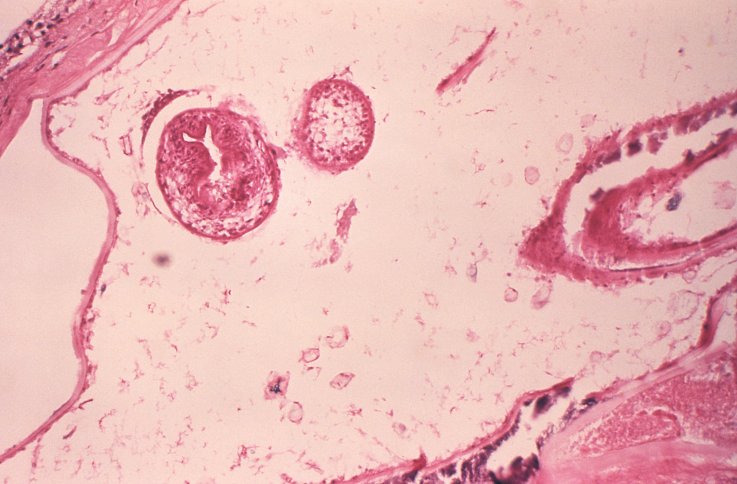Forum
WOMAN HAD 65 PERCENT OF LIVER REMOVED TO TREAT 'RARE CANCER,' ONLY TO BE TOLD SYMPTOMS WERE BEING CAUSED BY PARASITE
A woman from Alberta, Canada, who believed she was dying from a rare cancer was subsequently told by doctors that her symptoms were actually being caused by a parasite.
Toward the end of last year, 36-year-old Cassidy Armstrong began feeling severe pain in her ribs and was also experiencing weight loss, Global News reported.
Armstrong took herself to get checked out at the hospital and doctors recommended that she undergo an MRI scan. The scans revealed a large mass in her liver and medical staff subsequently diagnosed her with a rare form of liver cancer.
"I was basically getting ready to just die," Armstrong told Global News. "It didn't look good. It was pretty sad and scary."
After her diagnosis, Armstrong underwent surgery and during the procedure, surgeons removed around 65 percent of her liver, her whole gallbladder and some parts of her lungs.
However, when medical staff analyzed some of the tissue removed from Armstrong's body, they made a surprise finding—her symptoms were actually being caused by the presence of a parasitic tapeworm known as Echinococcus multilocularis.
"[Doctors] said, 'We have some good news for you. We don't think this is cancer. We think this is a parasite,'" Armstrong said. "I was like, 'This is good?' They're like, 'Yes, it's very good. It's much better.'"
Infection with the larva of this tapeworm—which is found primarily in foxes, coyotes, and dogs—can lead to a rare disease known as Alveolar echinococcosis (AE.) It involves the growth of cysts in the liver, or sometimes other organs such as the lungs and brain, according to the Centers for Disease Control and Prevention (CDC.)
These cysts grow at a slow rate, and thus, symptoms may not appear for several years. When they do, patients often report pain or discomfort in the upper abdomen, weakness and weight loss. These are similar to the symptoms reported by patients with liver cancer and liver cirrhosis. If AE is not treated, the disease can be fatal in some cases.
Armstrong may have been infected with Echinococcus multilocularis for around 10 years, doctors said. Medical staff have now prescribed her anti-parasitic medication.
"[Doctors are] saying that I might have a chance at a normal life expectancy, which is great," Armstrong said. "I'm forever grateful."
Humans can become infected with Echinococcus multilocularis after ingesting the eggs of the tapeworm via "hand-to-mouth" transfer or contamination, according to the CDC. For example, an individual could consume food which is contaminated with the feces of foxes or coyotes.

Or they could become infected after handling household dogs and cats which are contaminated with the eggs. These pets may become contaminated after coming into contact with infected rodents—or their feces.
Stan Houston, an infectious disease specialist from the University of Alberta, said that the parasite is seemingly becoming more common in the Canadian province. Fifteen human cases of the parasite have been confirmed in Alberta since 2013.
"This [parasite] is a totally new thing... this didn't used to be here," Houston told Global News.
Nevertheless, AE is found around the world—mostly in northern latitudes—with cases reported in central Europe, Russia, China, Japan, Central Asia and some parts of North America.
That is so scary! The thought of having a parasite in your body is unsettling...but I guess in her case its better than having cancer. Still unsettling to think that a tapeworm can live in the body for that long and continue to grow. I've seen pictures of tapeworms they have taken out of someone and it was huge! I also read they can grow up to 80 feel long and live up to 30 years if not treated. This is why it is super important never to eat raw meat and always wash your hands!
Yes, the thought of a tapeworm or other parasites is something you don't think of every day. Some seem quite easy to acquire. Washing hands after touching pets and as a rule, everything is crucial to keep yourself at less risk. Use hand sanitizer also to help in between washing the hands.
I saw a story of a man who loss his legs after his dog licking him. It can be very scary what we can get from animals. We don't think anything about it letting our dogs or cats lick us.
All I have to say is i'm glad my cat doesn't go outside. I had many cats that were indoor/outdoor cats, and now this has opened my eyes, to the potential risks we have with our pets. Even, if we don't let them run in the wild, they are still potentially exposed to many parasites, that can be brought back into the house, and impact the health of humans.
@mikaylaalleniectskin-com omg this is horrifying! I would be so upset if i caught something from my dog licking me.
This is a horrifying article. I watch a show about rare diseases people can catch that are deadly and it's the scariest show because it's things that are so uncommon they don't have a cure for it. Tapeworms really gross me out and give me anxiety just thinking about even getting one.
@laurenjohnsoniectskin-com The show Monsters Inside of Me always freaked me out because these people contracted parasites in ways they didnt think they would. It was a very descriptive show and it has always made me a little weary to eat raw foods (even sushi) or go out of the country.
@sydneymissaleiectskin-com Yes! But sometimes it was things that people couldn't control either. I'm very weird about the meat I eat and how it is prepared because parasites are very common from meat.
This article is horrifying, all of the shows and stories that show the things that have been living inside them for months or even years and people have no idea is scary. Ive experienced it first hand, my sister had been going back and forth to the doctor trying to figure out why she was loosing so much weight and they attributed it to the stress related illnesses she has, but come to find out she had a parasite for about a year. I never knew that ginger and wasabi was incorporated on the plate with sushi because it helps kill bacteria. I will force myself to eat it now just to be safe.
I never eat raw meat, fish etc. Pork has parasites so it has to be cooked to the correct temperature. I am hesitant to eat meat at resturants. I do not eat raw fish either.


